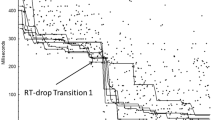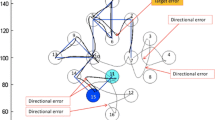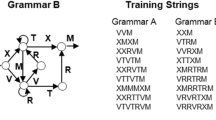Abstract
The present research was intended to examine the sequence learning ability of elderly people — with a focus on comparing sequences with different structural characteristics and on properly assessing explicit knowledge. Experiment 1 showed that learning-related improvements in serial reaction time task performance were greater for young than elderly subjects, and elderly subjects were especially poor at learning a sequence with complex structural characteristics. Measures of recognition memory showed that neither young nor elderly subjects showed above-chance explicit knowledge of the sequences. Experiment 2 was designed to test the validity and sensitivity of the explicit recognition measures by comparing young subjects in groups given all random trials, given sequence trials with implicit instructions, or given sequence trials with explicit instructions. Experiment 2 confirmed the sensitivity of the recognition measures to explicit knowledge, so it is concluded that group effects in Exp. 1 reflect age-related differences in implicit learning.
Similar content being viewed by others
References
Chapman, L. J., Chapman, J. P., Curran, T., & Miller, M. B. (1994). Do children and the elderly show heightened semantic priming? How to answer the question. Developmental Review, 14, 159–185.
Cherry, K. E., & Stadler, M. A. (1995). Implicit learning of a nonverbal sequence in younger and older adults. Psychology and Aging, 10, 379–394.
Cleeremans, A., & McClelland, J. L. (1991). Learning the structure of event sequences. Journal of Experimental Psychology; General, 120, 235–253.
Cohen, A., Ivry, R. I., & Keele, S. W. (1990). Attention and structure in sequence learning. Journal of Experimental Psychology: Learning, Memory, and Cognition, 16, 17–30.
Craik, F. I. M., Anderson, N. D., Kerr, S. A., & Li, K. Z. H. (1995). Memory changes in normal aging. In A. D. Baddeley, B. A. Wilson, & F. N. Watts (Eds.), Handbook of memory disorders (pp. 211–241). Chichester: John Wiley & Sons.
Craik, F. I. M., Morris, L. W., Morris, R. G., & Loewen, E. R. (1990). Relations between source amnesia and frontal lobe functioning in older adults. Psychology and Aging, 5, 148–151.
Curran, T. (1995). On the neural mechanisms of sequence learning. Psyche, 2 (12), URL:http://psyche.cs.monash.edu.au/volume21/psyche-95-2-12-sequence-1-curran.html.
Curran, T. (in press, a). Higher-order associative learning in amnesia: Evidence from the serial reaction time task. Journal of Cognitive Neuroscience.
Curran, T. (in press, b). Implicit sequence learning from a cognitive neuroscience perspective: What, how, and where? In M. Stadler & P. Frensch (Eds.), Handbook of implicit learning. Beverly Hills, CA: Sage.
Curran, T., & Keele, S. W. (1993). Attentional and non-attentional forms of sequence learning. Journal of Experimental Psychology: Learning, Memory, and Cognition, 19, 189–202.
Curran, T., Schacter, D. L., & Bessenoff, G. (1996). Visual specificity effects on word stem completion: Beyond transfer appropriate processing? Canadian Journal of Experimental Psychology, 50, 22–33.
Frensch, P. A., & Miner, C. S. (1994). Effects of presentation rate and individual differences in short-term memory capacity on an indirect measure of serial learning. Memory and Cognition, 22, 95–110.
Frensch, P. A., Buchner, A., & Lin, J. (1994). Implicit learning of unique and ambiguous serial transactions in the presence and absence of a distractor task. Journal of Experimental Psychology: Learning, Memory, and Cognition, 20, 567–584.
Grafton, S.T., Hazeltine, E., & Ivry, R. (1995). Functional mapping of sequence learning in normal humans. Journal of Cognitive Neuroscience, 7, 497–510.
Howard, D. V., & Howard, J. H. (1989). Age differences in learning serial patterns: Direct versus indirect measures. Psychology and Aging, 4, 357–364.
Howard, D. V., & Howard, J. H. (1992). Adult age differences in the rate of learning serial patterns: Evidence from direct and indirect tests. Psychology and Aging, 7, 232–241.
Jackson, G., & Jackson, S. (1992). Sequence structure and sequential learning: The evidence from ageing reconsidered (Technical Report 92-9). Eugene: University of Oregon, Institute of Cognitive and Decision Sciences.
Jackson, G. M., Jackson, S. R., Harrison, J., Henderson, L., & Kennard, C. (1995). Serial reaction time learning and Parkinson's disease: Evidence for a procedural learning deficit. Neuropsychologia, 33, 577–593.
Kausler, D. H. (1994). Learning and memory in normal aging. San Diego: Academic Press.
Keele, S. W., & Curran, T. (1995). Modularity of sequence learning systems in humans. In E. Covey (Ed.), Neural representation of temporal patterns (pp. 197–225). New York: Plenum.
Keele, S. W., & Jennings, P. J. (1992). Attention in the representation of sequence: Experiment and theory. Human Movement Studies, 11, 125–138.
Light, L. L., & La Voie, D. (1993). Direct and indirect memory in old age. In P. Graf & M. Masson (Eds.), Implicit memory: New directions in cognition, development, and neuropsychology (pp. 207–230). Hillsdale, NJ: Erlbaum.
Mitchell, D. B. (1993). Implicit and explicit memory for pictures: Multiple views across the lifespan. In P. Graf & M. Masson (Eds.), Implicit memory: New directions in cognition, development and neuropsychology (pp. 171–190). Hillsdale, NJ: Erlbaum.
Nissen, M. J., & Bullemer, P. (1987). Attentional requirements of learning: Evidence from performance measures. Cognitive Psychology, 19, 1–32.
Nissen, M. J., Knopman, D. S., & Schacter, D. L. (1987). Neurochemical dissociation of memory systems. Neurology, 37, 789–794.
Nissen, M. J., Willingham, D., & Hartman, M. (1989). Explicit and implicit remembering: When is learning preserved in amnesia. Neuropsychologia, 27, 341–352.
Parkin, A. J. (1993). Implicit memory across the lifespan. In P. Graf & M. Masson (Eds.), Implicit memory: New directions in cognition, development, and neuropsychology (pp. 191–206). Hillsdale, NJ: Erlbaum.
Parkin, A. J., & Lawrence, A. (1994). A dissociation in the relation between memory tasks and frontal lobe tests in the normal elderly. Neuropsychologia, 32, 1523–1532.
Perruchet, P., & Amorim, M. (1992). Conscious knowledge and changes in performance in sequence learning: Evidence against/dissociation. Journal of Experimental Psychology: Learning, Memory, and Cognition, 18, 785–800.
Rauch, S. L., Savage, C. R., Brown, H. D., Curran, T., Alpert, N. M., Kendrick, A., Fischman, A. J., & Kosslyn, S. M. (1995). A PET investigation of implicit and explicit sequence learning. Human Brain Mapping, 3, 271–286.
Reber, P. J. & Squire, L. R. (1994). Parallel brain systems for learning with and without awareness. Learning & Memory, 1, 217–229.
Reed, J., & Johnson, P. (1994). Assessing implicit learning with indirect tests: Determining what is learned about sequence structure. Journal of Experimental Psychology: Learning, Memory, and Cognition, 20, 585–594.
Rosenthal, R., & Rosnow, R. L. (1991). Essentials of behavioral research: Methods and data analysis. New York: McGraw-Hill.
Shanks, D. R., & St. John, M. F. (1994). Characteristics of dissociable human learning systems. Behavioral and Brain Sciences, 17, 367–447.
Shimamura, A. P. (1995). Memory and frontal lobe function. In M. Gazzaniga (Ed.), The cognitive neurosciences (pp. 803–813). Cambridge, MA: MIT Press.
Stadler, M. A. (1992). Statistical structure and implicit serial learning. Journal of Experimental Psychology: Learning, Memory, and Cognition, 18, 318–327.
Stadler, M. A. (1993). Implicit serial learning: Questions inspired by Hebb (1961). Memory & Cognition, 21, 819–827.
Stadler, M. A. (1995). Role of attention in implicit learning. Journal of Experimental Psychology: Learning, Memory, and Cognition, 21, 674–685.
Stadler, M. A., & Neely, C. B. (in press). Effects of sequence length and structure on implicit serial learning. Psychological Research/Psychologische Forschung.
Willingham, D. B., Greenley, D. B., & Bardona, A. M. (1993). Dissociation in a serial response time task using a recognition measure: Comment on Perruchet and Amorim (1992). Journal of Experimental Psychology: Learning, Memory, and Cognition, 19, 1424–1430.
Willingham, D. B., Nissen, M. J., & Bullemer, P. (1989). On the development of procedural knowledge. Journal of Experimental Psychology: Learning, Memory, and Cognition, 15, 1047–1060.
Author information
Authors and Affiliations
Rights and permissions
About this article
Cite this article
Curran, T. Effects of aging on implicit sequence learning: Accounting for sequence structure and explicit knowledge. Psychol. Res 60, 24–41 (1997). https://doi.org/10.1007/BF00419678
Received:
Accepted:
Issue Date:
DOI: https://doi.org/10.1007/BF00419678




